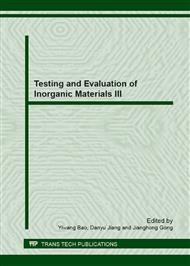p.144
p.148
p.152
p.156
p.162
p.167
p.172
p.178
p.183
Grain Boundary Phase Analysis for Y2O3-Doped AlN Ceramics
Abstract:
Y2O3 is a common sintering additive of AlN ceramics to achieve densification and remove the oxygen impurity, resulting in a typically grain boundary phase (GBP) Y3Al5O12 (YAG). Two AlN ceramics with 3wt% and 5wt% Y2O3 intended for thermal conductivity study were sintered at 1800 °C for 4h. X-ray diffraction (XRD) indicates that GBP could either be YAG or YAP (YAlO3) phase, while the selected area electron diffraction (SAED) and energy dispersive X-ray (EDX) in TEM identifies it as YAP instead of YAG. The electron back-scattering diffraction (EBSD) in SEM further confirms the general presence of YAP phase in both samples. In meanwhile, two types of Al-rich GBPs were also detected by TEM, which could account for extra dopant in the microstructure. GBP contents in the both samples were quantified by K-value method (XRD) and from backscattered electron images. Such analyses of GBPs are helpful to understand the sintering mechanism and evaluate their contribution to the thermal conductivity of AlN.
Info:
Periodical:
Pages:
162-166
Citation:
Online since:
March 2013
Authors:
Price:
Сopyright:
© 2013 Trans Tech Publications Ltd. All Rights Reserved
Share:
Citation:


